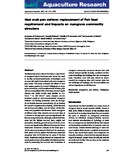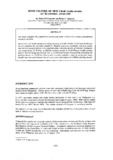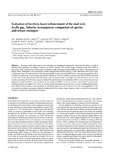Search
Now showing items 1-10 of 52
Economic feasibility analysis of the monoculture of mudcrab (Scylla serrata) Forsskal
Mudcrabs, Scylla serrata Forsskal, were monocultured at different stocking densities: 5000, 10 000, 15 000 and 20 000/ha for 90 days. Highest mean weight, survival and relative growth increment (P>0.05) were obtained from ...
Mud crab pen culture: replacement of fish feed requirement and impacts on mangrove community structure
(Blackwell Publishing, 2010)
Brackishwater pond culture has been a major factor in mangrove loss in Southeast Asia, hence, the need to develop environment-friendly technologies such as mud crab Scylla (Portunidae) culture in mangrove pens exists. This ...
Induction of moulting in hatchery-reared mangrove crab Scylla serrata juveniles through temperature manipulation or autotomy
(Wiley, 2019)
The effects of temperature and autotomy of chelipeds on survival, growth and moulting of mangrove crab (Scylla serrata) juveniles were investigated under laboratory conditions for 60 days. Hatchery‐produced crabs with ...
Expressions of molt-inhibiting hormone (MIH) and extracellular signal-regulated kinase (ERK) during the molting stages of the giant mud crab, Scylla serrata
(De La Salle University, 2017)
Survival and growth of mud crabs and any other crustaceans depend on molting. Molting is influenced by several hormones, two of which are Molt-Inhibiting Hormone {MIH} and a molt promoting hormone, the Extracellular ...
Mud crab culture
(John Wiley and Sons, 2000)
Mud crabs are one of the most widely sought crustacean species that inhabit the estuarine areas and tidal rivers and creeks of the Asian and Indo-Pacific regions. Hailed as "food for the gods," the mud crab is recognized ...
Pond culture of mud crab (Scylla serrata): an economic analysis.
(1992)
The study compares the profitability of mud crab pond culture with existing crab fattening practices in Iloilo, Philippines.
Monoculture of Scylla serrata at stocking densities of 5,000, 10,000, 15,000 and 20,000 pcs/ha ...
Series: ACIAR Working Paper;No. 54
Mud crab hatchery and grow-out status in the Philippines
(Australian Centre for International Agricultural Research, 2004)
Interest in mud crab aquaculture is increasing throughout the Philippines because of its demand both in local and export markets. Mud crab culture started as low-density polyculture with fish or shrimp using wild crab ...
Evaluation of hatchery-based enhancement of the mud crab, Scylla spp., fisheries in mangroves: comparison of species and release strategies
(CSIRO Publishing, 2009)
Ranching, stock enhancement and restocking are management approaches involving the release of wild or hatchery-bred organisms to enhance, conserve or restore fisheries. The present study, conducted from April 2002 to ...
Community-based technology transfer in rural aquaculture: The case of mudcrab Scylla serrata nursery in ponds in northern Samar, central Philippines
(Springer Verlag, 2014)
Finding aquaculture development approaches to open up livelihood opportunities for the rural poor and in mainstreaming smallholder fish farmers to reduce poverty remain a challenge. This paper examines the community-based ...
Aquasilviculture trials in mangroves in Aklan province, Panay Island, central Philippines
(Japan International Research Center for Agricultural Sciences, 2000)
To integrate production of crabs and shrimp with mangrove conservation, the SEAFDEC Aquaculture Department initiated studies on Mangrove-Friendly Aquaculture (MFA). Culture pens and ponds in old growth and newly regenerating ...











